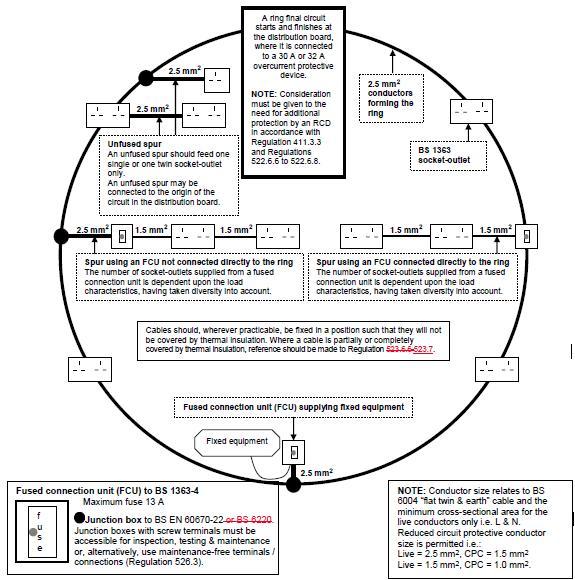The ring is a special case and there are some things not allowed even though at first it would seem there is no overload. For example your not allowed to take a spur with 4mm cable and feed daisy chained sockets even though the 4mm cable is rated high enough. This is because the ring may not load share across the two cables
AFAIAA, the regs don't actually forbid that, so one would have to be able to justify the design oneself. If, for example, the 4mm² (unfused) spur were attached at the midpoint of the ring, I would imagine that such a justification ought to be pretty straightforward, wouldn't you?
Kind Regards, John
I would agree John one could design an installation which does not follow all the rules laid down in regulations and the accompanying IET books.
Many of the rules we follow are in the guides Book 3 for example does refer to figure of 8 and how to test to ensure it does not exist but seen nothing in BS7671:2008 about that or things like maximum number of cables in a conduit.
Appendix 15 (Informative) is seen by many to be part of the regulations and the circle with all the options does not include using 4mm² it is only with the radial final circuit arrangements that a 4mm² unfused spur is shown.
I have argued that the appendix is not really part of the regulations however since one is tested on items found in the appendix when taking the C&G2382 many consider it to be part of the regulations.
I am sure you remember the 14th Edition where what is now published in the guide was then part of the main book. However at that time it was not a British Standard it only became a British Standard with the 16th Edition. Up to the 16th Edition I do not remember any exam on being able to read a book.
433.4.2, 434.4, 523.8, all have to be considered and the latter is interesting as it states it does not stop the use of a ring final circuit. However 434.2.1 does not state any such thing so one has to assume the 3 meter rule applies to a ring final circuit!
This is a DIY forum and although interesting to talk about the finer points of the regulations I think it is unlikely any DIY guy will be able to follow what we are talking about. The ring final circuit is in its self an odd phrase as it is often not the final circuit where FCU are used. I think
This is the link to the PDF showing the ring final circuit but not sure if non members can access it? So included picture for those who can't get it from website.



